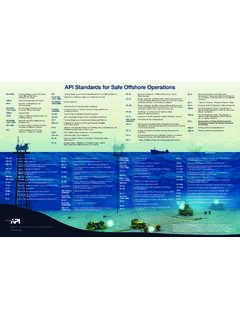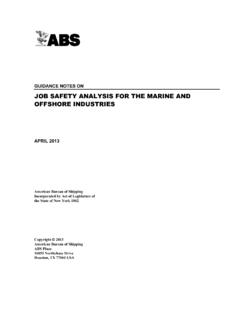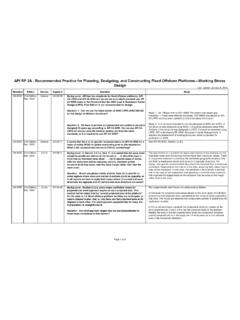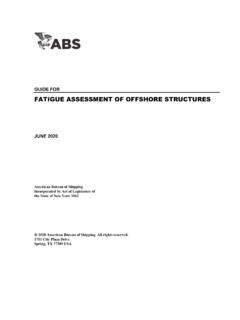Transcription of Offshore Structures: General Introduction
1 Offshore Structures: General Introduction OBJECTIVE/SCOPE To identify the basic vocabulary, to introduce the major concepts for Offshore platform structures, and to explain where the basic structural requirements for design are generated. SUMMARY The lecture starts with a presentation of the importance of Offshore hydro-carbon exploitation, the basic steps in the development process (from seismic exploration to platform removal) and the Introduction of the major structural concepts (jacket-based, GBS-based, TLP, floating). The major codes are identified. For the fixed platform concepts (jacket and GBS), the different execution phases are briefly explained: design, fabrication and installation.
2 Special attention is given to some principles of topside design. A basic Introduction to cost aspects is presented. Finally terms are introduced through a glossary. 1. Introduction Offshore platforms are constructed to produce the hydrocarbons oil and gas. The contribution of Offshore oil production in the year 1988 to the world energy consumption was 9% and is estimated to be 24% in 2000. The investment (CAPEX) required at present to produce one barrel of oil per day ($/B/D) and the production costs (OPEX) per barrel are depicted in the table below. Condition CAPEX $/B/D OPEX $/B Conventional Average 4000 - 8000 5 Middle East 500 - 3000 1 Non-Opec 3000 - 12000 8 Offshore North Sea 10000 - 25000 5 - 10 Deepwater 15000 - 35000 10 - 15 World oil production in 1988 was 63 million barrel/day.
3 These figures clearly indicate the challenge for the Offshore designer: a growing contribution is required from Offshore exploitation, a very capital intensive activity. Figure 1 shows the distribution of the oil and gas fields in the North Sea, a major contribution to the world Offshore hydrocarbons. It also indicates the onshore fields in England, the Netherlands and Germany. 2. Offshore PLATFORMS Introduction of Basic Types The overwhelming majority of platforms are piled-jacket with deck structures, all built in steel (see Slides 1 and 2). Slide 1 : Jacket based platform - Southern sector North Sea Slide 2 : Jacket based platform - Northern sector North Sea A second major type is the gravity concrete structure (see Figure 2), which is employed in the North Sea in the Norwegian and British sectors.
4 A third type is the floating production unit. Environment The Offshore environment can be characterized by: water depth at location soil, at seabottom and in-depth wind speed, air temperature waves, tide and storm surge, current ice (fixed, floes, icebergs) earthquakes (if necessary) The topside structure also must be kept clear of the wave crest. The clearance (airgap) usually is taken at approximately 1,50 m, but should be increased if reservoir depletion will create significant subsidence. Construction The environment as well as financial aspects require that a high degree of prefabrication must be performed onshore.
5 It is necessary to design to limit Offshore work to a minimum. The overall cost of a man-hour Offshore is approximately five times that of an onshore man-hour. The cost of construction equipment required to handle loads, and the cost for logistics are also a magnitude higher Offshore . These factors combined with the size and weight of the items, require that a designer must carefully consider all construction activities between shop fabrication and Offshore installation. Codes Structural design has to comply with specific Offshore structural codes. The worldwide leading structural code is the API-RP2A [1].
6 The recently issued Lloyds rules [2] and the DnV rules [3] are also important. Specific government requirements have to be complied with, in the rules of Department of Energy (DoE), Norwegian Petroleum Direktorate (NPD). For the detail design of the topside structure the AISC-code [4] is frequently used, and the AWS-code [5] is used for welding. In the UK the Piper alpha diaster has led to a completely new approach to regulation Offshore . The responsibility for regulatory control has been moved to the Health and Safety Executive (HSE) and the operator has to produce a formal safety assessment (TSA) himself instead of complying with detailed regulations.
7 Certification and Warranty Survey Government authorities require that recognized bodies appraise the aspects of structural integrity and issue a certificate to that purpose. The major certification bodies are: Det norske Veritas (DnV) Lloyds Register of Shipping (LRS) American Bureau of Shipping (ABS) Bureau Veritas (BV) Germanischer Lloyd (GL) Their requirements are available to the designer [2, 3, 6, 7, 8]. Insurance companies covering transport and installation require the structures to be reviewed by warranty surveyors before acceptance. The warranty surveyors apply standards, if available, on a confidential basis.
8 3. Offshore DEVELOPMENT OF AN OIL/GAS FIELD Introduction The different requirements of an Offshore platform and the typical phases of an Offshore development are summarized in [9]. After several initial phases which include seismic field surveying, one or more exploration wells are drilled. Jack-up drilling rigs are used for this purpose for water depths up to 100 - 120 m; for deeper water floating rigs are used. The results are studied and the economics and risks of different development plans are evaluated. Factors involved in the evaluation may include number of wells required, fixed or floated production facilities, number of such facilities, and pipeline or tanker off-loading.
9 As soon as exploitation is decided and approved, there are four main technical activities, prior to production: engineering and design fabrication and installation of the production facility drilling of production wells, taking 2 - 3 months/well providing the off loading system (pipelines, tankers, etc.). The drilling and construction interaction is described below for two typical fixed platform concepts. Jacket Based Platform for Shallow Water First the jacket is installed. The wells are then drilled by a jack-up drilling unit standing close by with a cantilever rig extending over the jacket.
10 Slide 3 shows a jack-up drilling unit with a cantilever rig. (In this instance it is engaged in exploratory drilling and is therefore working in isolation.) Slide 3 : Cantilevered drilling rig: Self-elevating (jack-up) exploration drilling platform. Design and construction of the topside are progressed parallel to the drilling, allowing production to start soon after deck installation. For further wells, the jack-up drilling unit will be called once again and will reach over the well area of the production deck. As an alternative to this concept the wells are often accommodated in a separate wellhead platform, linked by a bridge to the production platform (see Slide 1).







